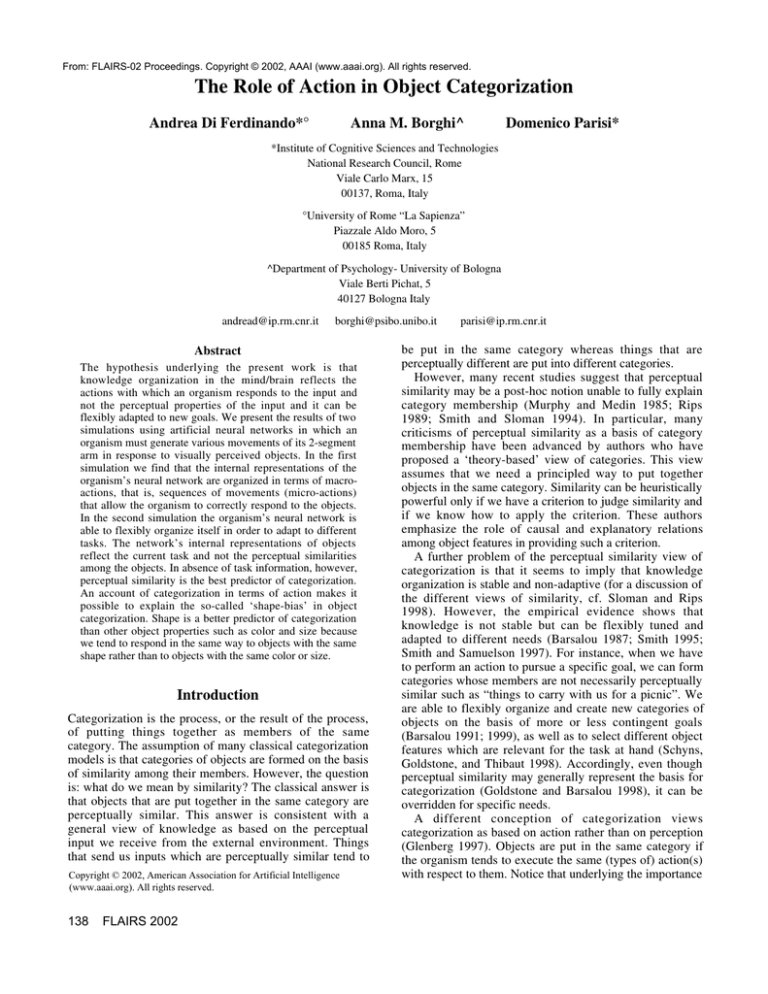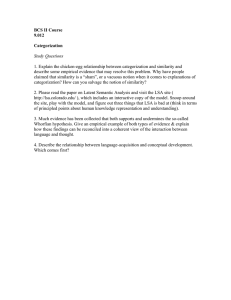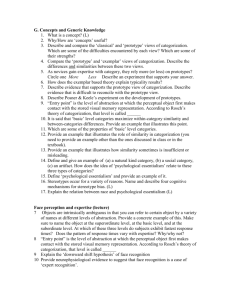
From: FLAIRS-02 Proceedings. Copyright © 2002, AAAI (www.aaai.org). All rights reserved.
The Role of Action in Object Categorization
Andrea Di Ferdinando*°
Anna M. Borghi^
Domenico Parisi*
*Institute of Cognitive Sciences and Technologies
National Research Council, Rome
Viale Carlo Marx, 15
00137, Roma, Italy
°University of Rome “La Sapienza”
Piazzale Aldo Moro, 5
00185 Roma, Italy
^Department of Psychology- University of Bologna
Viale Berti Pichat, 5
40127 Bologna Italy
andread@ip.rm.cnr.it
borghi@psibo.unibo.it
Abstract
The hypothesis underlying the present work is that
knowledge organization in the mind/brain reflects the
actions with which an organism responds to the input and
not the perceptual properties of the input and it can be
flexibly adapted to new goals. We present the results of two
simulations using artificial neural networks in which an
organism must generate various movements of its 2-segment
arm in response to visually perceived objects. In the first
simulation we find that the internal representations of the
organism’s neural network are organized in terms of macroactions, that is, sequences of movements (micro-actions)
that allow the organism to correctly respond to the objects.
In the second simulation the organism’s neural network is
able to flexibly organize itself in order to adapt to different
tasks. The network’s internal representations of objects
reflect the current task and not the perceptual similarities
among the objects. In absence of task information, however,
perceptual similarity is the best predictor of categorization.
An account of categorization in terms of action makes it
possible to explain the so-called ‘shape-bias’ in object
categorization. Shape is a better predictor of categorization
than other object properties such as color and size because
we tend to respond in the same way to objects with the same
shape rather than to objects with the same color or size.
Introduction
Categorization is the process, or the result of the process,
of putting things together as members of the same
category. The assumption of many classical categorization
models is that categories of objects are formed on the basis
of similarity among their members. However, the question
is: what do we mean by similarity? The classical answer is
that objects that are put together in the same category are
perceptually similar. This answer is consistent with a
general view of knowledge as based on the perceptual
input we receive from the external environment. Things
that send us inputs which are perceptually similar tend to
Copyright © 2002, American Association for Artificial Intelligence
(www.aaai.org). All rights reserved.
138
FLAIRS 2002
parisi@ip.rm.cnr.it
be put in the same category whereas things that are
perceptually different are put into different categories.
However, many recent studies suggest that perceptual
similarity may be a post-hoc notion unable to fully explain
category membership (Murphy and Medin 1985; Rips
1989; Smith and Sloman 1994). In particular, many
criticisms of perceptual similarity as a basis of category
membership have been advanced by authors who have
proposed a ‘theory-based’ view of categories. This view
assumes that we need a principled way to put together
objects in the same category. Similarity can be heuristically
powerful only if we have a criterion to judge similarity and
if we know how to apply the criterion. These authors
emphasize the role of causal and explanatory relations
among object features in providing such a criterion.
A further problem of the perceptual similarity view of
categorization is that it seems to imply that knowledge
organization is stable and non-adaptive (for a discussion of
the different views of similarity, cf. Sloman and Rips
1998). However, the empirical evidence shows that
knowledge is not stable but can be flexibly tuned and
adapted to different needs (Barsalou 1987; Smith 1995;
Smith and Samuelson 1997). For instance, when we have
to perform an action to pursue a specific goal, we can form
categories whose members are not necessarily perceptually
similar such as “things to carry with us for a picnic”. We
are able to flexibly organize and create new categories of
objects on the basis of more or less contingent goals
(Barsalou 1991; 1999), as well as to select different object
features which are relevant for the task at hand (Schyns,
Goldstone, and Thibaut 1998). Accordingly, even though
perceptual similarity may generally represent the basis for
categorization (Goldstone and Barsalou 1998), it can be
overridden for specific needs.
A different conception of categorization views
categorization as based on action rather than on perception
(Glenberg 1997). Objects are put in the same category if
the organism tends to execute the same (types of) action(s)
with respect to them. Notice that underlying the importance
of action for categorization does not mean that perception
doesn’t play a relevant role for categorization. Rather,
according to this view perception and action are strongly
interconnected, and perception is influenced by action
(Viviani and Stucchi 1992). In fact, different perceptual
features may become salient to fit the needs of the actions.
In addition, since it is frequently the case that objects with
respect to which the organism tends to execute the same
action(s) are perceptually similar, perceptual similarity can
become the basis on which objects may be classified
together. However, the real basis of categorization is
action, not perceptual similarity. Similarity of action is at
the origin of categorization and when the two criteria are in
conflict it is action that prevails, not perceptual similarity.
Simulations
In this paper we present some results of neural network
simulations that try to make more concrete and specific this
view of categorization as based on action. Our neural
networks control the behavior of organisms that live in a
bidimensional world and respond to visually perceived
objects by moving their (single) arm (see Figure 1).
Figure 1. The organism with its two-segment arm.
A neural network functions in discrete cycles. In each
cycle the network’s input units encode the content of the
organism’s retina and the proprioceptive feedback from the
arm; in fact the arm sends proprioceptive information to
the network specifying its current position, i.e. the current
angles between shoulder and forearm and between forearm
and arm. The network’s output units encode the movement
of the arm in that cycle (micro-actions), i.e., the variation
of the angles between shoulder and forearm and between
forearm and arm. To correctly respond to perceived
objects, the organisms must be able to generate an
appropriate sequence of such movements. We will call
macro-action a sequence of micro-actions at the end of
which the arm stops. Notice that each macro-action can be
realized by different sequences of micro-actions. For any
given object, the arm’s starting position can vary and, as a
consequence, the arm’s trajectory to reach the object will
be different.
Simulation 1
In a first simulation we have shown that visually perceived
objects are internally categorized in terms of the macroaction with which the organism responds to them rather
than in terms of their perceptual properties (Di Ferdinando
and Parisi 2001).
In this simulation the objects can be of two different
shapes (A and B; cfr. Figure 2) and they can appear either
in the left portion or in the right portion of the organism’s
retina. The organisms must respond according to the
following two rules:
1) When a single object is presented, the organism has to
reach for it, whatever the shape and the position of the
object.
2) When both object A and object B are presented, the
organism has to reach for object A, ignoring object B.
There are six possible visual inputs (Figure 2).
Figure 2. The two objects and the six visual inputs.
In the first three cases, the organism has to reach the left
portion of the visual space. In the last three cases the
organism has to reach the right portion of the visual space.
In other words, the organisms has to perform two different
macro-actions: “moving the arm toward the left portion of
the visual space” and “moving the arm toward the right
portion of the visual space”.
We used a genetic algorithm for evolving the network’s
connection weights allowing the organisms to generate the
appropriate behavior. The network architecture is shown in
Figure 3.
FLAIRS 2002
139
a succession of internal layers we might be able to observe
a more gradual mapping of visual into motor information.
In a second simulation (Borghi, Di Ferdinando, and
Parisi 2002) the organism’s neural network has three layers
of internal units, instead than a single one, so that the
visual input is progressively transformed by passing from
Figure 3. The network architecture.
At the end of evolution, we analyzed the internal
representations of the best organisms in order to understand
how the neural networks categorize the perceived objects.
In neural terms categorization means that input patterns
(vectors of activation states of the input units) that are
categorized together tend to be transformed into internal
patterns (vectors of activation states of the internal units)
that are close together in the abstract hyperspace of all
possible internal patterns, whereas input patterns that are
categorized as belonging to different categories tend to be
transformed into internal patterns that are more distant in
the hyperspace of internal patterns.
What we find is that visual inputs that must be
responded in the same way (with the same macro-action)
are categorized as belonging to the same category whereas
visual inputs that must be responded in different ways
(with different macro-actions) are categorized as belonging
to different categories (Figure 4).
Figure 4. Activation level of the 4 hidden units (columns)
in response to the six visual stimuli (rows) for one of the
organisms analyzed. The activation level is mapped into a
grey scale (0 = black and 1 = white).
Simulation 2
In the neural networks of the preceding simulation there
was a single layer of internal units, and we have found that
these internal units encode motor macro-actions rather than
visual information. If we provide our neural networks with
140
FLAIRS 2002
one layer to the next before reaching the output motor units
(Figure 5).
Figure 5. The new network architecture.
Moreover, in the new simulation the same visually
perceived object may be responded to with a variety of
different actions, not just one as in the preceding
simulation. The particular action with which the organism
responds to the visual input depends on the particular task
(goal) which currently controls the organism’s behavior. In
our simulations the current task is communicated to the
neural network from outside, by encoding the task as a
particular activation pattern in an additional set of input
units (task units). In real organisms task information can
also be internally generated inside the organism’s body or
even inside their neural network. The task input units send
their connections not to the first layer but to the second
layer of internal units which elaborate the visual input.
Notice that until the organism’s neural network is informed
about the current task, i.e., prior to the second layer, the
neural network cannot decide what is the appropriate action
with which to respond to the visual input. Given this
arrangement, we expect that in the early internal layers of
the network architecture, i.e., those nearer to the visual
input, the objects will tend to be represented and internally
categorized in terms of their visual properties whereas as
soon as the task information arrives to the subsequent
layers of internal units, the objects will be represented and
internally categorized in terms of the particular action with
which, given the current task, the organism has to respond
to the visual input.
In this second simulation there are four different objects,
A, B, C, and D, which are graphically represented as a 3x3
matrix in which 4 of the 9 slots are filled, as shown in
Figure 6.
1.2
1.0
Same
category
Distance
0.8
Different
category
0.6
0.4
0.2
0.0
1
2
3
Task
In any given episode the organism sees only one of the 4
objects and it is required to categorize the object in one of
two categories by pressing two different buttons with the
endpoint of its arm. There are three tasks which are
encoded in three task units. Task 1 is performed correctly if
the two categories are composed by perceptually similar
objects, i.e., objects with 3 common slots (A-B and C-D,
Figure 6), Task 2 if the two categories are composed by
objects with 1 common slot (A-C and B-D), and Task 3 if
the two categories are composed by perceptually dissimilar
objects, i.e., objects with no common slot (A-D and B-C).
In this case too we used a genetic algorithm for evolving
good organisms. At the end of evolution, after 3.500
generations, the performance of the organisms does not
differ in the three tasks. However, we find that Task 1
requires a smaller number of generations to be learned than
Task 2 and Task 3. Thus, categorization performance is
influenced by perceptual similarity between the objects.
Let us now turn to the analysis of the way objects are
internally represented in the neural networks of the best
organisms. We calculated the distance between pairs of
points (internal activation patterns) which represent the
objects in the hyperspace of each layer of internal units. In
the first layer, where task information hasn’t arrived yet,
the closest points are those which represent perceptually
similar objects while the more distant points are those
which represent perceptually dissimilar objects. Thus, in
absence of task information categorization is predicted by
perceptual similarity between the objects.
But what happens in the second and third internal layers,
when task information has arrived? In the second layer, the
critical one, the closest points are those representing
objects which are responded to with the same macro-action
(see Figure 7). As expected, already at this level task
information overrides perceptual similarity. However,
perceptual similarity still plays a role in this second layer.
In fact, the result is stronger for Task 1 (highly
perceptually similar objects) than for Task 2 (less
1.2
1.0
Same
category
0.8
Distance
Figure 6. The four objects. Perceptual similarity of pairs of
objects (number of shared filled slots) is also indicated.
perceptually similar objects) and for Task 3 (perceptually
dissimilar objects).
Figure 7. Second hidden layer: distances between the
points representing the activation patterns of objects
belonging to the same vs. different categories in the three
tasks.
In the third internal layer action clearly overrides
perceptual similarity. As in the second layer, the smallest
distances are those between points representing objects
which require the same response. However, in the third
layer the result is stronger than in the second layer and
there are no differences among the three tasks (see Figure
8). In other words, at this level of neural processing
perceptual input is represented in terms of the macroactions with which the organism must respond to the input
Different
category
0.6
0.4
0.2
0.0
1
2
3
Task
and not in terms of the perceptual properties of the input.
Figure 8. Third hidden layer: distances between the points
representing the activation patterns of objects belonging to
the same vs. different categories in the three tasks.
Discussion
Our simulations can be interpreted as showing that
categorization is action-based. Assigning a relevant role to
action in categorization does not mean that perceptual
similarity between objects is unimportant (Hampton 1998;
Goldstone and Barsalou 1998). In everyday life
perceptually similar objects generally elicit similar actions
and therefore we probably have evolved the ability to
respond in the same way to perceptually similar objects
FLAIRS 2002
141
(Gibson 1979). Empirical evidence shows that the
affordances of objects direct our attention and activate
particular kinds of actions. Preparation to act on an object
produces faster processing of stimuli congruent with that
object (Craighero et al. 1999), thus we are faster to respond
in the same way to perceptually similar objects. However,
as recently shown by Tucker and Ellis (1998), the way
visual objects are represented may include information on
how to act upon them.
An account of categorization in terms of actions can
explain why shape is more important than other properties
of objects such as color or size in determining how objects
are categorized and why nouns tend to refer to objects that
have the same shape (Biederman 1987; Landau, Smith, and
Jones 1998; Shyi et al. 2001; Smith 1995). If categories of
objects depend on perceptual similarity, it is not clear why
perceptual similarity in shape is more important than
perceptual similarity in color or size in forming object
categories. The answer becomes clear if we recognize that
action, not perceptual similarity, is the real basis of object
categorization. For organisms such as us, objects that tend
to be responded to with the same action(s) are more likely
to be objects that have the same shape but can have
different colors or sizes, whereas objects that tend to be
responded to with different actions are more likely to be
objects with different shapes and, perhaps, the same color
or size. In some experiments texture emerges as another
property of objects which plays an important role in object
categorization. Texture tends to distinguish animals from
nonanimals, and we behave in very different ways in
response to animals than nonanimals. Hence, in this case
too objects which vary in texture tend to be placed in
different categories based on the actions with which we
respond to them.
References
Barsalou, L. W. 1987. The instability of graded structure:
implications for the nature of concepts. In U. Neisser
ed., Concepts and conceptual development: Ecological
and intellectual factors in categorization, 101-140.
Cambridge, Mass.: Cambridge University Press.
Barsalou, L. W. 1991. Deriving categories to achieve
goals. In G. H. Bower ed., The psychology of learning
and motivation: Advances in research and theory, Vol.
27, 1-64. New York: Academic Press.
Barsalou, L. W. 1999. Perceptual Symbol Systems.
Behavioral and Brain Sciences 22: 577-609.
Biederman, I. 1987. Recognition by components: A theory
of human image understanding. Psychological Review
94: 115-147.
Borghi, A. M., Di Ferdinando, A., and Parisi, D. 2002. The
role of perception and action in object categorization. In
J. A. Bullinaria and W. Lowe eds., Proceedings of the
seventh neural computation and psychology workshop:
connectionist models of cognition and perception.
Singapore: World Scientific.
142
FLAIRS 2002
Craighero, L., Fadiga, L., Rizzolatti, G., and Umiltà, C.
1999. Action for perception: a motor-visual attentional
effect. Journal of Experimental Psychology: Human
Perception and Performance 25: 1673-1692.
Di Ferdinando, A., and Parisi, D. 2001. Micro-actions and
macro-actions in neural networks, Technical Report,
NSAL-01-03, Institute of Psychology, CNR, Rome.
Gibson, J. J. 1979. The ecological approach to visual
perception. Boston: Houghton Mifflin.
Glenberg, A. M. 1997, What memory is for. Behavioral
and Brain Sciences 20: 1-55.
Goldstone, R. and Barsalou, L. W. 1998. Reuniting
cognition and perception. The perceptual bases of rules
and similarity. Cognition 65: 231-262.
Hampton, J.A. 1998. Similarity-based categorization and
fuzziness of natural categories. Cognition 65: 137-165.
Landau, B., Smith, L. and Jones, S. 1998. Object Shape,
Object Function, and Object Name. Journal of Memory
and Language 38: 1-27.
Murphy, G. L. and Medin, D. L. 1985. The role of theories
in conceptual coherence. Psychological Review 92: 289316.
Rips, L. J. 1989. Similarity, typicality, and categorization.
In S. Vosniadou and A. Ortony eds., Similarity and
analogical learning. New York: Cambridge University
Press.
Schyns, P. G., Goldstone, R. L., and Thibaut, J. P. 1998.
Development of features in object concepts. Behavioral
and Brain Sciences 21: 1-54.
Shyi, G. S. W., Goldstone, R. L., Hummel, J. E., and Lin,
C. 2001. Computing representations for bound and
unbound object matching. Forthcoming.
Sloman, S. A., and Rips, L. J. 1998. Similarity as an
explanatory construct. Cognition 65: 87-101.
Smith, E. E., and Sloman, S. A., 1994. Similarity versus
rule-based categorization. Memory and Cognition 22:
377-386.
Smith, L. B. 1995. Stability and Variability: the geometry
of children’s novel-word interpretations. In F. D.
Abraham and A. R. Gilgen eds, Chaos theory in
psychology. London: Praeger.
Smith, L. B, and Samuelson, L. L. 1997. Perceiving and
Remembering: Category Stability, variability and
Development. In K. Lamberts and D. Shanks eds,
Knowledge, Concepts, and Categories, 161-195. Hove:
Psychology Press.
Tucker, M., and Ellis, R. 1998. On the relations between
seen objects and components of potential actions.
Journal of Experimental Psychology: Human Perception
and Performance 24: 830-846.
Viviani, P., and Stucchi, N. 1992. Biological movements
look uniform, evidence for motor-perceptual
interactions. Journal of Experimental Psychology,
Human Perception and Performance 18: 603-623.







